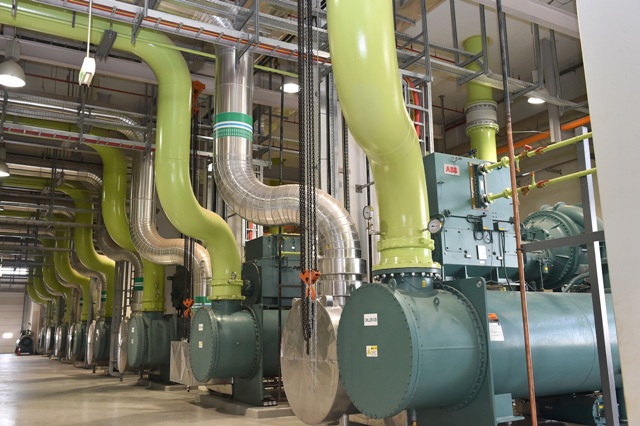By Sudheer Perla, Country Manager – India, Tabreed
The climate crisis is looming, and the world is entering the most decisive decade in human history to confront global warming. Sustainability is at the heart of this transformation as stakeholders work together to mitigate the climate challenges. Air-conditioning is one area that has tremendous potential for reducing carbon footprint and greenhouse gas emissions.
The International Energy Agency estimates that as the rest of the world continues to develop, air conditioning will use approximately 13% of global electricity, and produce 2-bn tonnes of CO2 a year. Closer home, about 8% of India’s 249-mn households were air conditioned as of March 2018. Even as this number is expected to rise to 50% by 2050, it would not only mean a notable increase in energy needs but also a sharp rise in the emission of greenhouse gases used in air conditioning. Now is the time to embrace new technologies that offer sustainable and efficient cooling.
The District Cooling solution
A sustainable, cost-effective cooling solution, district cooling aggregates the demand and relies on a centralised cooling plant to provide cooling to buildings within its grid. The plant supplies chilled water through a network of underground insulated pipes using renewable energy sources for chilled water production as well as thermal energy storage to cut peak energy demand.This cooling system is ideal for large-scale business districts, airports, university campuses, commercial establishments, and mixed used developments.
District cooling is increasingly becoming the preferred cooling choice, delivering significant operational and cost efficiencies, while reducing energy consumption and CO2 emissions, thereby enabling businesses and governments to meet their energy sustainability targets. District heating or cooling systems are already widely prevalent in many parts of the world, either as a public utility like in the Scandinavian countries or as a captive or outsourced utility model like in the Gulf Cooperation Council (GCC) countries. For instance, the district cooling system for Dubai Downtown provides over 1,35,000 refrigeration tonnes of cooling to buildings in a 2-sq.km. the radius that includes Burj Khalifa and Dubai Mall, serving more than 50,000 end-users through four inter-connected cooling plants.
Aggregating efficiencies
In 2013, the UN Environment Programme studied low-carbon cities worldwide to identify key factors for their success in scaling up energy efficiency, usage of renewable energy and attaining targets for low emissions. The study of 45 champion cities revealed the reliance on district energy systems as a best practice for providing local, affordable, and low-carbon energy supply. Since then, UNEP’s District Energy in Cities Initiative has been gaining momentum in many parts of the world, accelerating district heating or cooling adoption through cities applying a systems-thinking approach to move towards climate resilient, resource-efficient, and low-carbon pathways.
A growing number of cities around the world are incorporating district cooling into their smart energy networks. Fortune Business Insights estimate that the global district cooling market is likely to grow at a CAGR of 8.7%, from $26.50 billion in 2021 to $47.64 billion in 2028.
The India potential
Urbanisation, rising temperatures, and economic growth have led to India’semergence as the fastest growing cooling market globally. Moreover, for India, recognising 'cooling as a development need' is important since it is linked with achieving the targeted sustainable development goals, such as health and well-being (SDG-3), decent work and economic growth (SDG-8), sustainable cities (SDG-11), and climate action (SDG-13). The National District Cooling Potential Study, conducted by the Union Ministry of Power’s outfit EESL in partnership with UNEP, estimates that India is likely to be the largest consumer of space cooling in the world with space cooling potentially accounting for 28% of electricity demand.
Cognizant of the situation, the Government of India is already taking initiatives to adopt sustainable cooling systems. The India Cooling Action Plan (ICAP), published by the Ministry of Environment, Forests & Climate Change provides a 20-year perspective and outlines actions needed for sustainable cooling, identifying district cooling as a key medium-term initiative to be adopted. The UNEP-EESL study estimates the potential for 274 district cooling systems in India by 2038, meeting 9-mn refrigeration tons of cooling demand. With an investment potential of $35 billion, this will shave 6GW of energy demand and cut 6.6-mn tonnes of annual CO2 emissions, while saving $10.5 billion in capex for DISCOMs.
Future of District Cooling In India
District Cooling systemscan play a key role for India to meet its climate targets whilst ensuring cost-effective and sustainable thermal comfort for all. Early adopters are already enjoying the dividends of the district cooling system. The GIFT City in Gujarat has an operational district cooling system meeting cooling demand for both, free-zone and non-free zone developers and end-users.Amaravati in Andhra Pradesh has successfully tendered for a large DCS system in the government complex area; its procurement documents and proposed business model can be replicated in other parts of the country.
Under the Ministry of Environment’s ICAP, UNEP and EESL are supporting five cities to explore district cooling projects. Rajkot and Thane have been selected as pilot cities and Rajkot Municipal Corporation became the first in India to incorporate district cooling in its Smart City plan. Enabling both, the government as well as private players to implement direct cooling plans, global majors are now offering their expertise to Indian stakeholders, providing award-winning, high quality, efficient and environmentally-friendly district cooling solutions and delivering shareholder value.






